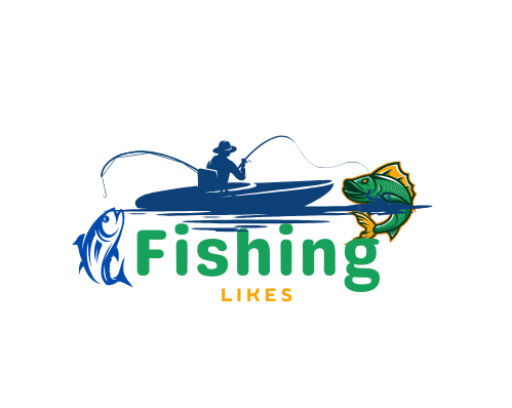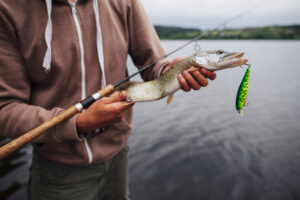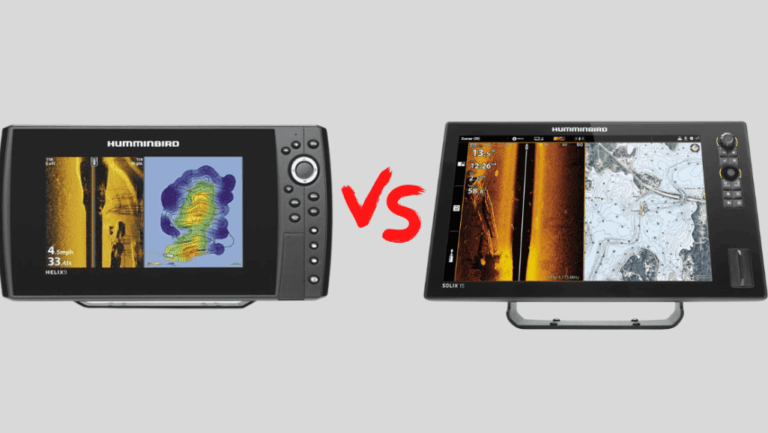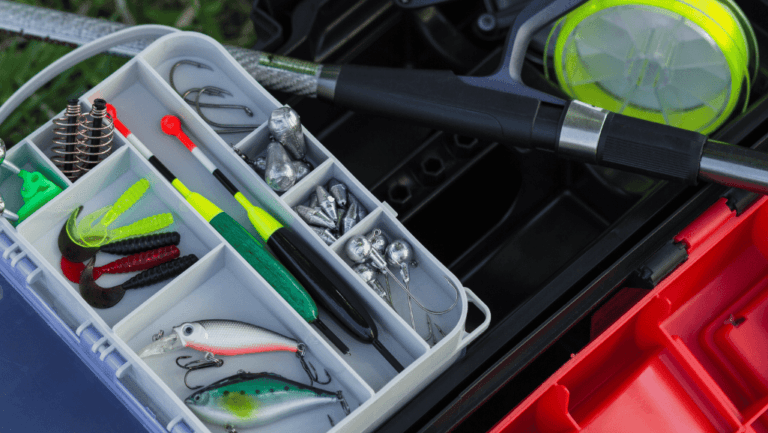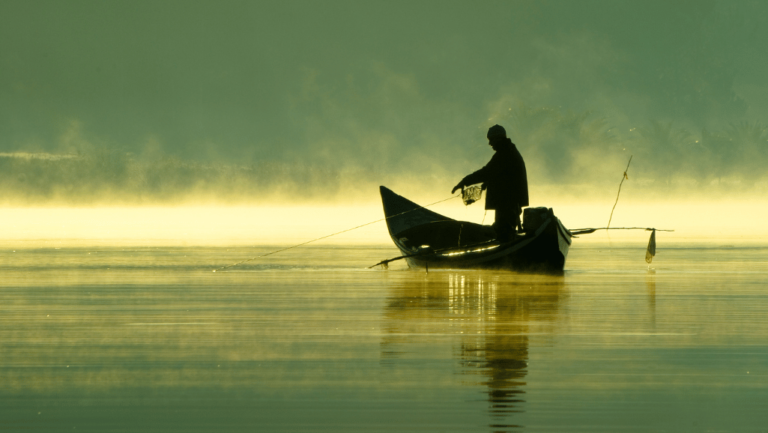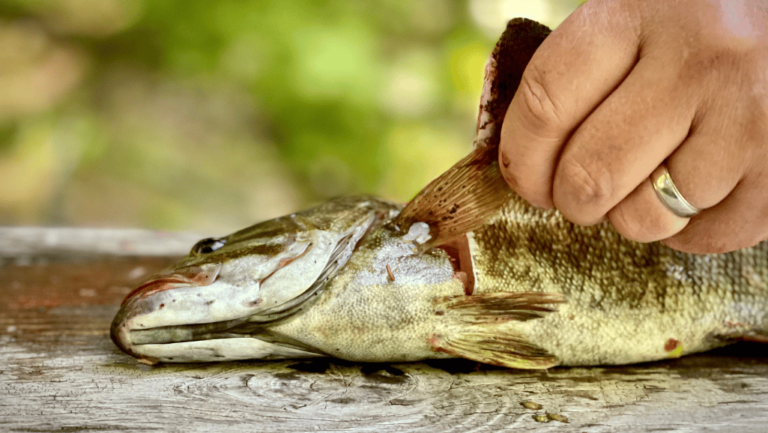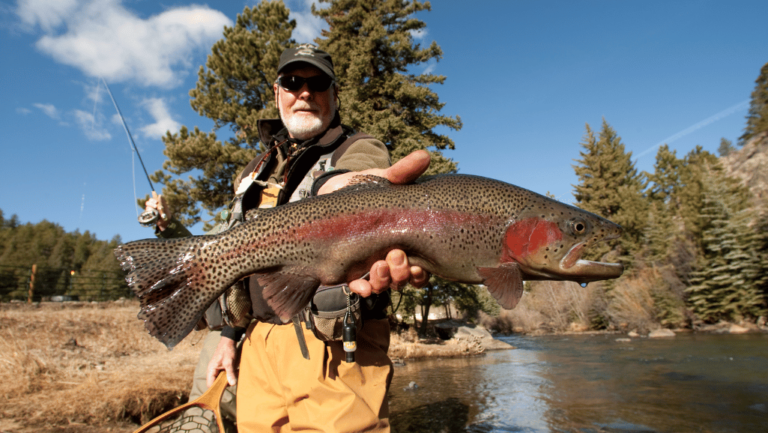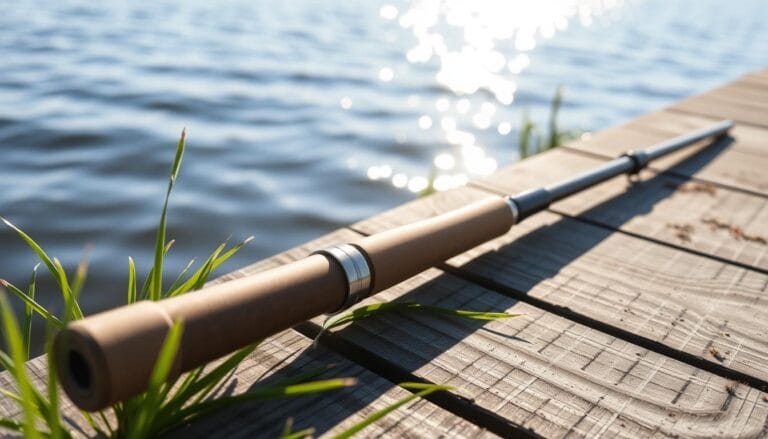Pike fishing is thrilling but you need to be well-prepared. This fish is known for its aggressive behavior and sharp teeth. They usually weigh 3 to 7 pounds. However, some are as big as 30 pounds. To catch these predators, you need the right fishing gear. Make sure you have medium to heavy rods, durable reels, and good lures.
For pike fishing, your gear must include strong reels. These should have a minimum drag of 15 pounds for casting and 25 pounds for trolling. Use a braided line of 15 to 20 pounds with a 15-pound drag. For a 25-pound drag, go for 30 to 40-pound line. Also, always use a 3 to 4-foot fluorocarbon leader. This protects your line against the pike’s teeth.
When fishing for pike, use a range of lures. These can be soft plastics, spinnerbaits, topwater lures, or jerk baits. Spoon lures, about 1/4 to 1 ounce, in gold and silver work well. Soft plastic swim-baits in bright colors are also good. Don’t forget about inline spinners. The color of the spinner blade should suit the water you’re fishing in.
It’s important to know how pike behave to catch them. When it’s warm, they spread out. In colder times, they look for deeper, stable spots. You’ll find them near inlets, bays, or areas with logs and weeds. Target these places for better chances of catching one.
Switch your bait’s speed and where you fish to attract more pike. When a pike bites, set the hook upwards firmly. Remember, it’s best to let them go after you catch them. This helps keep pike numbers healthy for the future.
Key Takeaways
- Select medium to heavy action rods and reels with strong drag systems.
- Use braided lines of 15-20 pounds for casting and 30-40 pounds for trolling.
- Employ a variety of lures, including soft plastics, spinnerbaits, and spoons.
- Focus on seasonal pike behavior to identify optimal fishing locations.
- Practice catch-and-release to sustain pike populations.
Introduction to Pike Fishing
Pike fishing is a thrilling sport for both new and experienced anglers. These fierce fish with sharp teeth are a challenge to catch. Known as Northern Pike in many places, they live in different bodies of fresh water.
Success in pike fishing depends on knowing where they are and what they eat. Pike are known to hide and attack quickly. They eat various things, so choosing the right bait is important.
Anglers look for pike in the North, mainly from Wisconsin to Canada. This region is great for catching big pike. The average large pike is over 35 inches and puts up a good fight when caught.
Having the right fishing gear is crucial for pike fishing. Use a strong fishing line and a wire leader to protect against their teeth. Reels like Daiwa Steez and lures like Storm swimbaits work well. For big pike, live bait like suckers can be a smart choice.
By knowing the basics and some good tips, you can improve your chance of catching a big pike. It’s also essential to fish responsibly to protect this popular fish for the future.
Understanding Pike Behavior
Getting to know pike behavior can really help you catch more fish. These fish are clever hunters that follow unique habits. Knowing when and where they like to hang out boosts your fishing luck. It’s essential to understand how their behavior changes with the season.
The Importance of Location
Location plays a huge role in catching pike. They love deep, calm waters, especially when it’s warmer than 75 degrees Fahrenheit. These places like northern banks and deep drop-offs are their favorite spots. Also, in the shallows, near bays where they spawn, you can find them. Knowing where to look makes catching them easier.
Seasonal Patterns and Habits
Pike act differently as the seasons change. In spring, when it’s about 40 degrees, they get ready to spawn. They often move to shallower parts. However, in summer, they head to deeper, cooler water. Fall is the best time to fish for them as they feed a lot and are easier to predict. They also stay active even in cold weather.
To catch more pike, you need to fish smart. Use strategies that fit how pike hunt, like the figure-eight retrieve. This move can get you more bites close to your boat. Remember to fish responsibly too. With the right knowledge and approach, you can have a successful and fun time fishing for pike.
Essential Gear for Pike Fishing
Anglers targeting pike need special pike fishing equipment. This gear must be strong to handle the pike’s power and aggressiveness. For tackle, look for rods that are medium to heavy-duty with quick tips. These rods provide enough strength and agility to catch pike that weigh between 10 and 20 pounds, especially the large ones found in the wild.
It’s also key to have reels with strong drag systems that can hold a lot of fishing line. With the right setup, anglers can control a pike’s fast and strong bursts without breaking their gear. If you’re going for larger pike, choose spinning outfits that can hold 14 to 20-pound-test or medium-heavy baitcasting setups with 17 to 20-pound-test. For smaller pike, gear with lighter spinning outfits or baitcasting setups ranging from 6 to 14-pound-test is good.
Using the right lures is important. Pike often bite at lures that look like what they eat. So, use lures that mimic the look of small fish. Colors such as white, yellow, and chartreuse work well because pike think they look like the bellies of their prey. In late spring, topwater lures work best over weed beds when the water gets to 60 degrees Fahrenheit.
Other essential tackle for pike fishing includes strong landing nets and tools like long-nose pliers or hook removers. These help protect both the angler and the pike by allowing for safe handling. For those who enjoy fly fishing, a 9-weight fly rod and reel are best for huge pike, while a lighter 7-weight setup suits smaller to medium pike.
Choosing the right pike fishing equipment is crucial. It not only makes fishing for pike more fun but also boosts your chances of catching them.
Choosing the Best Pike Fishing Rod
Choosing the best pike fishing rod is key to a great catch. Look for rods that are medium to heavy. These rods help you control your cast and feel even a tiny bite. This is important when dealing with big fish like pike.
For big pike weighing between 15 to 30 pounds, you need a strong rod and reel. The reel should have a drag of 25 pounds or more. If you’re after smaller pike, a 15-pound drag reel will do the job.
Using a braided line is a must. It’s very strong and won’t let you down. Choose a line that matches the power of your reel. A braided line between 15 to 20 pounds is good for most situations. For bigger fish, go with a 30 to 40-pound line.
It’s also smart to know about different rod and reel brands. Some great ones are Shimano and St. Croix. They are well-known for being top-notch. Don’t forget to have the right tools on hand to safely handle pike. Long needle-nose pliers, a jaw spreader, and a fish lip gripper are a must.
Getting the right best pike fishing rod means finding trusty equipment. A rod that’s about 7 to 7′ 9″ long is ideal. It helps you cast well and fight big fish like pike. With the right gear, your fishing trip will be more fun and successful.
The Best Lures for Pike Fishing
Pike anglers understand the need to pick the right bait for these fierce fish. The top pike lures look like real prey. This tempts pike to strike. Let’s explore proven lures known for their success.
The Johnson Silver Minnow is a century-old favorite. It’s known for its variety and sturdiness as pike fishing tackle. The Eppinger Dardevle Spoon is famous for its special design and red-white colors. This makes slow pike interested.
Today, we have lures like the Storm Wildeye Live Pike. It looks very real and moves like a fish, making it an excellent bait for pike fishing. The Suick Thriller jerkbait acts like an injured fish. It’s great for attracting big pike.
Some anglers like spinners. The Mepps #5 spinner is known for always working well. The Blue Fox Bullet Spinner #5 has a bigger hook, which is great for big pike. The Rat-L-Trap crankbait makes strong vibrations. These vibrations catch pike’s attention from far away.
| Lure | Type | Key Features |
|---|---|---|
| Johnson Silver Minnow | Spoon | Versatility, Longevity |
| Eppinger Dardevle Spoon | Spoon | Unique Shape, Proven Pattern |
| Storm Wildeye Live Pike | Swimbait | Realistic Appearance, Natural Motion |
| Suick Thriller | Jerkbait | Wounded Fish Simulation |
| Mepps #5 Spinner | Spinner | Consistency, Performance |
| Blue Fox Bullet Spinner #5 | Spinner | Larger Hook |
| Rat-L-Trap | Crankbait | Loud Vibrations |
If you like lures that make waves, try the BOOYAH Pikee. It’s great for fish on the surface. The Cisco Kid Topper lures have rotating blades. They make water disturbances that attract pike.
Knowing about the pike in your area can help you pick the best bait. Whether it’s a swimbait that looks real or a spinner that shines, having different lures is key. It makes sure you’re ready for any fishing adventure.
Top Techniques for Pike Fishing
To catch pike, anglers need to know special pike fishing techniques. Use big lures for big pikes, like those weighing 3 to 7 pounds. Or go for the really large ones, 15 to 30 pounds, when trolling. Changing how fast you pull back your line can make your lure seem like an injured fish. This tempts the pike to attack.
A good pike fishing rod is about 7 feet long. It should bend a little when you move it, so go for a medium or medium-heavy action. Your reel must be strong too. Look for one with a powerful drag—15 pounds for casting and 25 pounds for trolling. For the fishing line, use braided types. Choose 15 to 20-pound braid for reels with 15-pound drag and 30 to 40-pound braid for reels with 25-pound drag.
Many lures work well for pike. For spoons, pick ones weighing between 1/4 and 1 ounce. Gold and silver are good color choices. Soft swim-baits in bright colors like chartreuse, red, and yellow can also attract pike’s attention. Dark inline spinners are great for fishing at dusk or dawn. But during the day, go for spinner blades in bright colors like chartreuse and yellow.
Before you cast your line, look at the water closely. Spot places with lots of plants, small fish, and logs underwater. When fishing in weedy spots, use lures that won’t get caught easily, like weedless spoons. Or try soft swim-baits made to avoid getting snagged. When you throw your line, do it in a fan motion. This way, you will fish the spot fully, giving you more chances to catch pike.
When a pike bites, you must react quickly. Set the hook hard, pulling your rod up. This is key because pike can be tricky and might let go if you’re not fast enough. Most pike caught are between 20 and 40 inches, and they weigh from 2 to 20 pounds. But, some can weigh over 40 pounds. So, have a strong net, 20 to 36 inches wide, to safely land your catch.
Tips for Landing Large Pike
Landing big pike needs the right gear and methods. It’s also key to handle them safely for you and the fish.
Handling and Safety Tips
Make sure to handle pike safely. Use the right gear like a strong net, about 20 to 36 inches. This net helps prevent harm to you and the pike. Also, use tools like long-nose pliers to take out hooks safely.
Choose a rod with medium-heavy power for pike in the 15 to 30-pound range. Pair it with a reel that has a strong drag, 15 pounds or more. For trolling, use even stronger gear, at least 25-pound drag. These setups can land big pike without the line breaking.
Best Times and Conditions to Fish
Fishing for pike when conditions are right boosts your success. Aim for water temperatures between 60-65°F to catch big ones. The best time is post-spawn, when the water warms and the giants get active.
Fish at dawn or dusk for more success. Trolling with a strong rod can work well then. A 3 to 4-foot leader made of 20-40 pound fluorocarbon can handle a large pike’s first run.
Catching big pike is thrilling. With safety and the right conditions in mind, your pike fishing trip can be both fun and successful.
Best Baits for Pike Fishing
When you’re pike fishing, using live bait can give you an edge. Pike love fresh meals, like minnows, leeches, and nightcrawlers. Using these baits plays on the pike’s natural hunting behavior. It boosts your chances of catching one.
A smart way to fish with live bait is by using a slip bobber. With this setup, you can change how deep your bait sits in the water. This trick is great for all kinds of fishing spots. Also, you can add weight to keep your bait at the right depth, perfect for deep waters or areas with lots of plants.
It’s key to use bait that fits your hook just right. This helps with getting a good hook set when a pike bites. Big pike need a big enough bait to be interested. This way, you’re more likely to hook one well.
When you feel a bite, you must act fast and firmly. Lifting your rod sharply sets the hook well, stopping the fish from getting away. This is a top move in the list of pike fishing tips from the experts.
These are the main tools and tricks you’ll need for a good pike fishing day:
| Equipment | Recommendation |
|---|---|
| Reel’s Drag System | 15-pound maximum drag |
| Braided Line Weight | 15-20 pounds for 15-pound drag, 30-40 pounds for 25-pound drag |
| Net Size Range | 20-36 inches |
| Recommended Swimbaits Colors | Chartreuse, Red, Yellow, White |
| Blade Color in Murky Water | Darker Shades |
| Blade Color in Clear Water | Chartreuse, Yellow, White |
Use live bait and the right fishing methods to catch more pike. Pick your bait and method based on where you’re fishing. This makes your fishing smarter and more successful.
Common Mistakes in Pike Fishing
Knowing and fixing pike fishing mistakes helps you catch more fish. Using the wrong gear is a big issue. It’s essential to pick the right rod and reel. Your rod should be 7 feet long with medium to heavy action. And make sure your reel has enough power to handle the pike’s strong pulls. Always match your gear to the fish you’re after.
Many anglers miss fish by not changing how they reel in their line. Pike like different speeds and bait movements. To catch more fish, switch up how you cast your line. A casting method that lets you aim your bait over a wide area is smart. Try using different baits and tactics, like weedless spoons in plants or spinners near logs. Being flexible is key to avoiding common mistakes in pike fishing.
Fishing in the wrong spots is a mistake too. Best places to find pike are in inlets, bays, and coves with deep or changing water. They also love spots with lots of hiding places, like logs and banks. By knowing the right locations and fishing at the best times, you can catch more fish. Also, it’s vital to handle pike carefully when you catch and release. Always use the right tools, like pliers, a jaw spreader, and lip grippers, to keep both you and the fish safe.
| Equipment | Recommendation |
|---|---|
| Rod Size | 7 feet medium to medium-heavy action |
| Reel Drag for Casting | At least 15 pounds |
| Reel Drag for Trolling | At least 25 pounds |
| Braided Line for Casting | 15 to 20 pounds |
| Braided Line for Trolling | 30 to 40 pounds |
| Net Size | 20 to 36 inches |
| Hook Removal Tools | Long needle-nose pliers, jaw spreader, fish lip gripper |
Being aware of these tips improve your fishing and help protect pike. This knowledge not only increases your fishing success but also helps preserve pike populations.
Best Setup for Pike Fishing
Creating the best pike fishing setup is about picking the right gear mix and learning key techniques. Anglers looking to reel in pike must think about their gear’s strength.
An ideal setup has a tough rod and reel. Think about a baitcaster with a 5.3 gear ratio and a medium-heavy 6’6″ to 7′ rod. Pair them with a 20-pound monofilament line. Or, pick a 35 series spinning reel, a 6’6″ medium-heavy fast rod, and 12-14 pound monofilament line. Good choices are Ambassadeur 6500 C3 and Pflueger Purist reels.
When it comes to lures, having a lot to choose from is smart. Use spoons and swimbaits in various colors. For deep waters or weeds, go for inline spinners or weedless spoons. These work well.
Having the right gear is a must. For casting, pick a reel with a 15-pound drag minimum. For trolling, you’ll need a reel with a 25-pound drag. Use braided lines from 15 to 40 pounds depending on the setup. And, a 20-40 pound fluorocarbon leader is also helpful.
A good landing net, between 20 and 36 inches, and tools like a jaw spreader are needed. Advanced techniques, like casting in a fan shape, and setting hooks just right, boost your chances. By combining top-notch gear with the latest tactics, you can up your pike fishing game.
| Component | Recommended Options |
|---|---|
| Rod | Medium-heavy, 6’6″ to 7′, St. Croix Premier |
| Reel | Ambassadeur 6500 C3, Pflueger Purist, Quantum Smoke 7.0:1 |
| Line | 20-pound monofilament or 30-pound braid |
| Leader | 20-40 pound fluorocarbon |
| Lures | Dardevle Spoon, Heddon Lucky 13, Mepps Aglia |
Conclusion
Pike fishing success is all about knowing how these fish act and using the right gear. For the biggest pikes, look for those between 20 to 40 inches. They weigh from 2 to 20 pounds but can be way bigger than this. You need a strong spinning or baitcasting rod. It should be medium to heavy and have a quick tip. Make sure your reel is up to the job with a good drag system too.
When it comes to lure choice, go for spinnerbaits, crankbaits, and such. These lures, along with topwater and jerk baits, work well in different situations. Live bait like minnows and leeches are also good choices. Adapt your fishing style to where you’re fishing. For example, using fast or slow retrieval can make a big difference. Remember, let the pikes go after and help keep their numbers strong.
To be a top pike angler, you need a mix of know-how and the right tools. Getting a quality fishing rod and the best lures for the job is key. With the right strategy, anglers can not just catch big pikes but also help the environment. Remember, fishing smart and with care is what makes the sport great for everyone.
